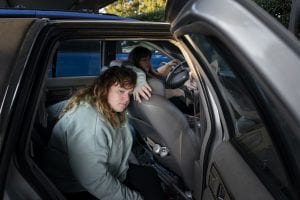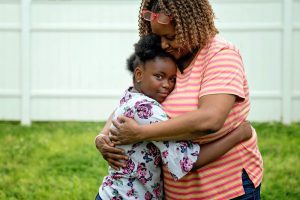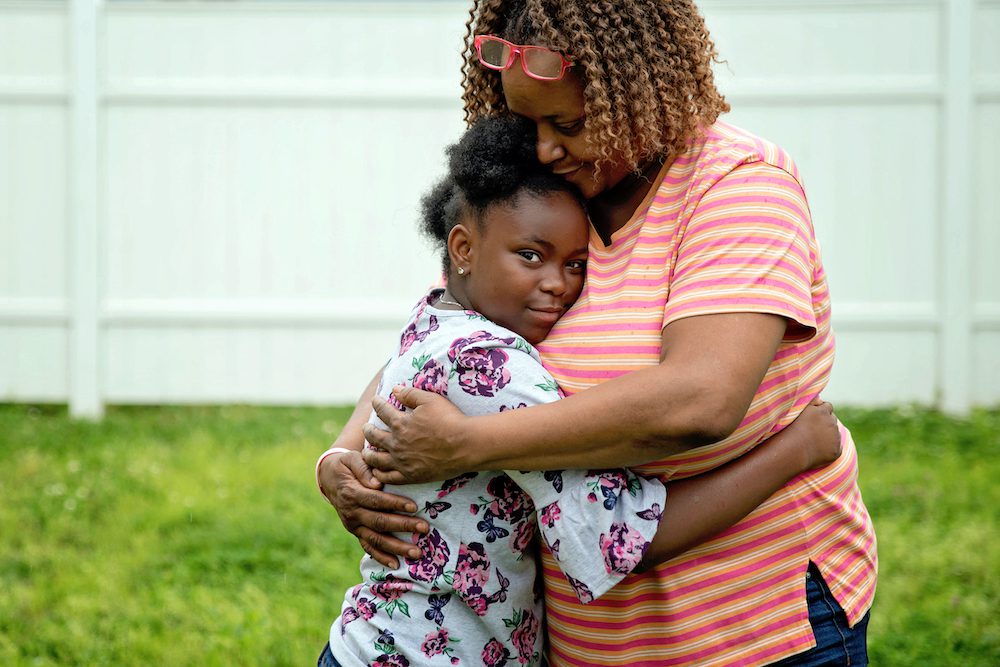
A family served by Family Promise. Photo by Rachel Bujalski, courtesy of Family Promise
My mom and I moved to Brooklyn after she broke up with a boyfriend. She was single and the apartment in Flatbush was the sixth household I would live in before I started kindergarten a few months later. Jobless, she aspired to work at the United Nations as an interpreter. That never came to pass, but she found employment through an unlikely source.
To entertain her preschooler, she would take me to a local pet store to play with puppies. After one of our frequent visits, the owner asked her if she was looking for work: His dog groomer was pregnant and about to leave.
My mom got the job with no relevant skills other than a love of animals and an abundance of gumption. She even started her own business grooming pets in people’s homes, with me in tow.
She made a decent wage, and we could afford our apartment off Foster Avenue; in 1970 that was unusual, a single mom living on her own.
Today, one-quarter of all children are in single-parent homes, overwhelmingly headed by a mother. Having only one parent has always tracked with less opportunity and more challenge compared with two-parent households, but a recent Pew Research study about single moms should concern us: “67.4 percent of ‘unpartnered mothers’ were employed and at work in September 2020, down from 76.1 percent a year earlier.”
As the CEO of Family Promise, a national nonprofit addressing family homelessness in more than 200 communities across the U.S., that statistic does more than give me pause; it dismays me. Anecdotally, we all know about two-parent families that have one parent, overwhelmingly the mom, who leaves their job to manage the new realities around remote schooling. For “unpartnered” mothers, that is not just a decision with dubious gender politics; it puts them on a continuum that will chug closer to homelessness if the trend does not reverse.
It would have for my mom if she had lost her job. My father was absent and uninterested in paying child support. My mom’s parents were dead; her sister estranged; her brother across the ocean. She had been in the country seven years by then and had a few friends, no assets, and really, no options. Ours would have been like three quarters of families experiencing homelessness: single parent, female headed.
There are many reasons to prevent families like the millions identified in the Pew study from becoming homeless. But one of the most compelling is to end future homelessness for the next generation. Depending on geography, as many as one-third of adults who are homeless first experienced the loss of housing before they were 18, when they were children. That is a pipeline; in our COVID times, the flow is threatening to flood.
The American Rescue Plan puts up sandbags, but the problem is at the source. The line between the Pew findings and future homelessness is blurred by NIMBY fights, industry orthodoxies, and a willful refusal to recognize homelessness as systemic, endemic, and self-perpetuating. There is an inextricable connection between housing instability for children and homelessness for adults.
That recognition is crucial if the new administration expects to make any progress on ending homelessness.
Overall, President Joe Biden’s plans on housing are compassionate, strategic, and comprehensive. They are centered on equity, which must be addressed to make true progress on housing. They allocate funding toward solutions, including extensive rental assistance, poverty alleviation like the Child Tax Credit, and the creation of 2 million new affordable housing units, they expand housing choice vouchers, champion fair housing, and use regulation and enforcement to undo structures that propagate our affordable housing crisis. The plans also prioritize and address marginalized populations like domestic violence survivors and those returning from incarceration.

A family served by Family Promise. Photo courtesy of Family Promise
Where they fall short is the amount and kind of attention given to family homelessness. The plans for homelessness allow the travesty around the limited definitions of homelessness to go unchallenged, perpetuating the HUD standard that excludes families that the U.S. Department of Education (DOE) and other departments rightly consider homeless—those in untenable doubled-up arrangements, staying in motels—from many benefits. It elides engagement with other departments, notably the U.S. Department of Health and Human Services (through the Administration for Children and Families), which would have significant impact because it is often more connected with children at risk, through Head Start, The Family and Youth Services Bureau, and other programs, than HUD. They do not meaningfully distinguish family homelessness from homelessness overall. They threaten to perpetuate rehousing models better suited for singles, ignoring the complexities of families who interface with schools, communities, employment, and social services in myriad ways and whose challenges are predominated by poverty and lack of opportunity, not dysfunction. Ultimately, we need to prioritize evidence, engagement, and holistic solutions on a community level rather than rely on theory and concept.
The numbers tell a story. HUD and its policy partners over the past 10 years cite a nearly 30 percent decrease in family homelessness. Why? In part, if you reduce complex housing situations to simplified definitions such as ‘sheltered’ or ‘not sheltered’, ‘unhoused’ or ‘doubled up’, you can find success within that specific scope and ignore the broader landscape. However, the DOE identifies approximately 1.5 million school-age children experiencing homelessness. This is double what it was a decade ago and counters the assumption we make about the effect of the economy on homelessness. In 2010, the Great Recession was in roar and we had double-digit unemployment. But we ended the decade with the most robust job numbers in generations. Job loss spiked with COVID, but the DOE statistic is pre-pandemic. Additionally, an estimated 420,000 students who are homeless have not been identified or enrolled this past year, a statistic that is as unsurprising in our current climate as it is disheartening.
As we know, homelessness is just a symptom of poverty. If we want to use illness as a metaphor, apt given our current times, then why aren’t we vaccinating our most vulnerable, children, against it? With a nearly 10 percent drop in employment among single moms, the numbers of children who will become homeless will soar.
If 2020 were 1970, I would likely be one of those children. In a pandemic, having a stranger come into your home to groom your dog is the definition of avoidable risk and my mom’s income would have evaporated.
Stimulus funding might have helped us, but unemployment insurance for lost gig work has proven difficult to secure. Maybe Mrs. Seeger, our landlady, would have forborne our eviction even without a moratorium. But at some point, the junction between her bills and our lack of money would have been crossed. And where would we be?
Unfortunately, this is the same place so many families are. The Biden administration can undo policies and approaches of the previous administration that gutted fair housing and opportunity and encouraged exclusionary practices. But it also must undo philosophies from the administration preceding that one that were exclusionary of the whole scope of data, holistic solutions, and local innovation. Biden rightly touts the Obama administration’s success in curbing veterans’ homelessness (although HUD Secretary Fudge just anointed it a top priority again). But it cannot ignore approaches that threaten to put so many children on a path to becoming veterans of homelessness.
We have a sad history of 10-year plans to end homelessness that did little beyond create systems to redefine how success is measured to conform to treasured philosophies. Children in kindergarten at the start of those are young adults now, often grappling with economic uncertainty and dim prospects for the future. Without a realistic definition of the problem itself, we will just continue to serve ideology, not people.
The Biden administration must be realistic about the true scope of family homelessness and integrate its realities into its efforts to cut child poverty. By creatively investing more parties in the response and courting local, holistic approaches, we no longer try only to solve today’s challenges. We build the foundation for a future without homelessness.
Which is what we all want.





Excellent article. At the Shimberg Center here in Florida, we use homeless student counts from our state Department of Education to estimate families and unaccompanied youth who are doubled up with others and in hotels and motels, in addition to the point-in-time estimates. By expanding the definition, we’ve found that family homelessness has increased over the past decade, even though the PIT counts have gone down. Using student data also helps us track the sudden effects of hurricanes on children’s homelessness.
100% Anne. A doubled up family often will be or was a family in shelter or in their car within a few months. Get to the essential condition, not its manifestation.
When HUD can’t/won’t remedy the problem (homelessness) it “fixes the numbers” (changing annual count requirements from prevalence to “point in time”). That way it can claim success by showing reduced numbers.
Claas and Andrea – Simplified solutions promulgated by a powerful marketing machine is far too easily digested by a public appetite for quick solutions.
Needed is sunlight to expose the true costs of not addressing the root causes of homelessness, and to unpack the true meanings behind HUD definitions and data.
Also needed are systems of support that do not socialize persons into entitlement dependence.
Purpose, dignity and empowerment coaching (i.e. Mobility Mentoring) to address root issues will require time, measured investments and accountability.
Great article. Completely agree. We need a much better response to homeless families and we need to actually solve the problem not define it away, and we need to recognize that family homelessness is about poverty, high housing prices and structural barriers/racism– not personal dysfunction